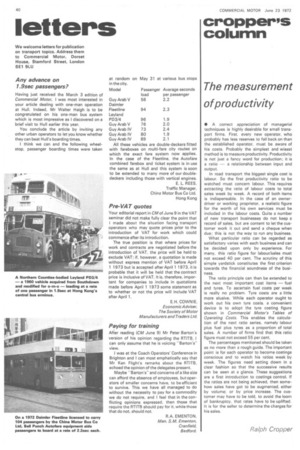cropper's column
Page 40

If you've noticed an error in this article please click here to report it so we can fix it.
The measurement of productivity
• A correct appreciation of managerial techniques is highly desirable for small transport firms. First, every new operator, who probably has less reserves to fall back on than the established operator, must be aware of his costs. Probably the simplest and wisest method is to measure productivity. Productivity is not just a fancy word for production; it is a ratio a relationship between input and output.
In road transport the biggest single cost is labour. So the first productivity ratio to be watched must concern labour. This requires extracting the ratio of labour costs to total sales week by week. A record of both items is indispensable. In the case of an ownerdriver or working proprietor, a realistic figure for the worth of his own services must be included in the labour costs. Quite a number of new transport businesses do not keep a record of sales, but are content to let the customer work it out and send a cheque when due; this is not the way to run any business.
What particular ratio can be regarded as satisfactory varies with each business and can be decided upon only by experience. For many, this ratio figure for labour/sales must not exceed 40 per cent. The scrutiny of this simple yardstick constitutes the first criterion towards the financial soundness of the business.
The ratio principle can then be extended to the next most important cost items — fuel and tyres. To ascertain fuel costs per week is really no problem. Tyre costs are a little more elusive. While each operator ought to work out his own tyre costs. a convenient device is to adopt the tyre costing figure shown in Commercial Motor's Tables of Operating Costs. This enables the calculation of the next ratio series, namely labour plus fuel plus tyres as a proportion of total sales. A number of firms find that this ratio figure must not exceed 55 per cent.
The percentages mentioned should be taken as no more than a rough guide. The important point is for each operator to become coatings conscious and to watch his ratios week by week. The figures need setting down in a clear fashion so that the successive results can be seen at a glance. These suggestions are a first introduction to castings control. If the ratios are not being achieved, then somehow sales have got to be augmented, either by volume: or by price increase. The customer may have to be told, to avoid the loom of bankruptcy, that rates have to be uplifted. It is for the seller to determine the charges for his sales.












































































































